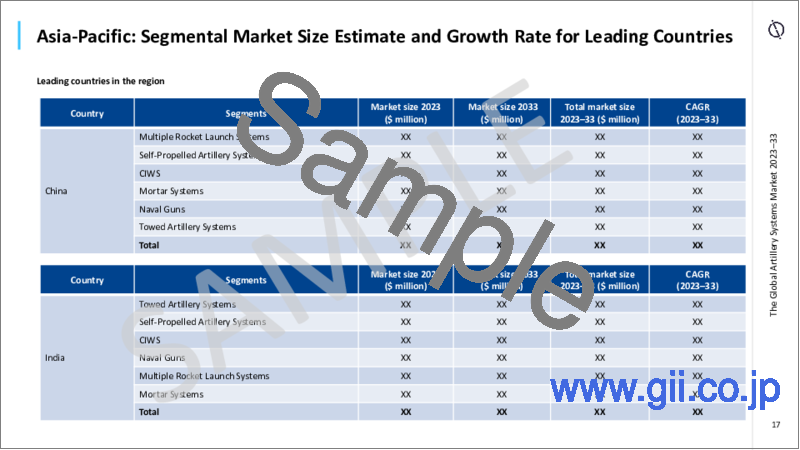|
|
市場調査レポート
商品コード
1320916
砲兵システム市場:規模および動向分析(セグメント、主要プログラム、競合情勢、2023~2033年の予測)Artillery Systems Market Size and Trend Analysis Including Segments, Key Programs, Competitive Landscape and Forecast, 2023-2033 |
||||||
カスタマイズ可能
適宜更新あり
|
|||||||
| 砲兵システム市場:規模および動向分析(セグメント、主要プログラム、競合情勢、2023~2033年の予測) |
|
出版日: 2023年06月30日
発行: GlobalData
ページ情報: 英文 63 Pages
納期: 即納可能
|
- 全表示
- 概要
- 目次
世界の砲兵システムの市場規模は予測期間中に4.0%のCAGRで拡大すると予測されています。予測期間中、アジア太平洋が40.2%の市場シェアで世界の砲兵システム市場を独占し、次いで欧州、北米地域が続くと予想されます。
陸戦技術は、技術的に改善された脅威の台頭により、過去10年間で大きな変化を遂げており、それによって軍は、これらの新たな課題を中和するために、より新しい砲兵システムを採用する必要があります。さらに、砲兵システムの需要は、アジア太平洋、欧州、中東・アフリカを含むいくつかの地域で進行中の領土紛争や国境紛争によっても牽引されると予想されています。攻撃能力を強化するため、先進的な長距離・高精度砲や多連装ロケットシステムの調達需要が高まっています。さらに、米国、インド、中国、ロシアなどの主要軍事大国による近代化構想が、今後数年間にわたり砲兵システム市場を牽引すると予想されます。
自走砲システム分野は最大の分野であり、予測期間中に世界の砲兵システム市場の39.8%を占めると予想されます。欧州、アジア太平洋、中東地域の主要国による自走砲システム調達のための多額の投資が、予測期間中の市場成長を促進すると予測されています。
アジア太平洋は2023年から2033年まで世界の砲兵システム市場を独占すると予想されます。この地域全体の地政学的緊張は、領土紛争とともに、この地域の国々によるいくつかの新しい砲兵システムの調達の急増を促しています。中国の優位性は、PGL-625自走砲システム、PHL-16多連装ロケット発射システム、PHL-11多連装ロケット発射システムといった現在進行中のプログラムに起因しています。調達量が多いのは、中国がこの地域で支配的な軍事力を確立するために、軍事近代化のイニシアチブをとっているためです。インドは、砲兵システムの第2位の調達国であり、現在進行中のいくつかの高価値のプログラムを持っています。
当レポートでは、世界の砲兵システム市場について調査し、セグメント別、地域別の動向、今後の予測などを提供しています。
目次
- エグゼクティブサマリー
- 世界の砲兵システム市場:概要
- 市場力学
- 需要促進要因
- 動向
- 技術開発
- 主要な課題
- 世界の砲兵システム市場:セグメント分析
- セグメント分析:自走砲システム
- セグメント分析:多連装ロケット砲システム
- セグメント分析:牽引砲システム
- セグメント分析:海軍砲
- セグメント分析:CIWS
- セグメント分析:モルタルシステム
- 世界の大砲システム市場- 地域分析
- 世界砲兵システム- 地域概要
- 地域分析:アジア太平洋
- サプライヤーシェア分析
- 地域の主要国
- 地域別の数量シェア
- 地域分析:欧州
- 地域分析:北米
- 地域分析:中東
- 地域分析:アフリカ
- 地域分析:ラテンアメリカ
- 競合情勢と主要プログラム
- 主要な市場参入企業
- 主要プログラム
- お問い合わせ
Abstract
Artillery Systems Market Size and Trend Analysis Including Segments (Self-Propelled Artillery Systems, Towed Artillery Systems, Mortar Systems, Multiple Rocket Launch Systems (MRLS), Naval Guns, and Close-In Weapon System (CIWS)), Key Programs, Competitive Landscape and Forecast, 2023-2033
The Global Artillery Systems Market 2023-2033 report provides the market size forecast and the estimated Compound Annual Growth Rate (CAGR) for the next ten years. The report covers industry analysis including the key market drivers, trends, emerging technologies, and major challenges faced by industry participants. It also offers insights regarding key factors and government programs that are expected to influence the demand for artillery systems market over the forecast period.
Land warfare techniques have undergone significant changes over the past decade due to the rise of technologically improved threats, thereby requiring militaries to employ newer artillery systems to neutralize these emerging challenges. In addition, the demand for artillery systems is also anticipated to be driven by the ongoing territorial and border conflicts in several regions, including Asia-Pacific, Europe, the Middle East, and Africa. There is a growing demand for procurement of advanced long range and high precision artillery and multiple launch rocket system for enhanced attack capabilities. Furthermore, the modernization initiatives by major military powers such as the US, India, China, and Russia are anticipated to drive the artillery systems market over the coming years.
The self-propelled artillery systems segment is expected to be the largest segment and is expected to account for 39.8% of the global artillery systems market over the forecast period. Heavy investment for the procurement of self-propelled artillery systems by some of major countries in Europe, Asia-pacific, and Middle East regions is anticipated to drive market growth over the forecast period. According to Chandan Kumar Nayak, Defense Analyst at GlobalData: "The accuracy of indirect fire, delivered at long ranges by artillery systems, has improved considerably over the years. This has been possible due to the incorporation of advanced onboard computers and targeting sensors into artillery systems. Modern self-propelled artillery systems can integrate and process data from a wide range of sources: EO/IR sensors, observation, counter-battery radars, UAVs, reconnaissance aircraft, and satellites. The future military theater will mainly be characterized by precise, intense, and short engagements. These technological advancements are expected to further propel the growth of artillery systems market over the next decade."
Asia-Pacific region is expected to dominate the global artillery systems market from 2023 to 2033. Geopolitical tensions across the region, along with territorial disputes, have prompted a surge in the procurement of several new artillery systems by the countries in the region. China's dominance is attributed to its ongoing programs, such as the PGL-625 self- propelled artillery systems, the PHL-16 multiple rocket launch systems, and the PHL-11 multiple rocket launch systems. The high procurement can be attributed to China military modernization initiatives to establish itself as the dominant military force in the region. India is the second largest procurer of the artillery system and has several high-value ongoing programs, with the latest procurement of one of the most advanced indigenously developed towed artillery systems, 'ATAGS'.
Key Highlights
- The global artillery systems market is expected to grow at a CAGR of 4.0% over the forecast period.
- The global artillery systems market is classified into six categories: Self-Propelled Artillery Systems, Towed Artillery Systems, Mortar Systems, Multiple Rocket Launch Systems (MRLS), Naval Guns, and Close-In Weapon System (CIWS).
- Asia-Pacific is expected to dominate the global artillery systems market over the forecast period with a market share of 40.2%, followed by Europe and North American regions.
- Self-Propelled Artillery Systems is expected to be the largest segment over the forecast period.
Who Should Buy
- Defence Startup's, original equipment manufacturers (OEMs), defence planners, artillery systems integrators, venture capital firms, government agencies, head of marketing, head of sales, CEOs and senior executives.
- The concerned stakeholders can utilize the report to identify high growth segments and customize their offerings to match the project requirements.
- The venture capital firms can utilize the project details, growth rate, and market size to identify and fund high potential startups.
Scope
In particular, the report provides an in-depth analysis of the following -
- Market size and drivers: Detailed analysis during 2023-2033, including the demand drivers and growth stimulators. It also provides a snapshot of the spending and modernization patterns of different regions around the world.
- Recent developments and industry challenges: Insights into technological developments and a detailed analysis of the existing artillery projects being executed and planned worldwide. It also provides trends of the changing industry structure and the challenges faced by industry participants.
- Regional highlights: study of the key markets in each region, providing an analysis of the key segments that are expected to be in demand.
- Major programs: details of the key programs in each segment, which are expected to be executed during 2023-2033.
- Competitive landscape and strategic insights: analysis of the competitive landscape of the global artillery systems market. It provides an overview of key players, their strategic initiatives, and financial analysis.
Reasons to Buy
- Determine prospective investment areas based on a detailed trend analysis of the global artillery systems over the next ten years
- Gain in-depth understanding about the underlying factors driving demand for different artillery systems segments in the top spending countries across the world and identify the opportunities offered by each of them
- Strengthen your understanding of the market in terms of demand drivers, industry trends, and the latest technological developments, among others
- Identify the major channels that are driving the global artillery systems market, providing a clear picture about future opportunities that can be tapped, resulting in revenue expansion
- Channelize resources by focusing on the ongoing programs that are being undertaken by the defense ministries of different countries within the global artillery systems market
- Make correct business decisions based on in-depth analysis of the competitive landscape consisting of detailed profiles of the top artillery systems solution providers around the world. The company profiles also includes information about the key products, alliances, recent contract awarded, and financial analysis, wherever available
Table of Contents
Table of Contents
- Executive Summary
- Global Artillery Systems Market: Overview
- Market Dynamics
- Demand Drivers
- Trends
- Technological Developments
- Key Challenges
- Global Artillery Systems Market: Segment Analysis
- Segment Analysis: Self-Propelled Artillery Systems
- Segment Analysis: Multiple Rocket Launch Systems
- Segment Analysis: Towed Artillery Systems
- Segment Analysis: Naval Guns
- Segment Analysis: CIWS
- Segment Analysis: Mortar Systems
- Global Artillery Systems Market - Regional Analysis
- Global Artillery Systems - Regional Overview
- Regional Analysis: Asia Pacific
- Supplier share analysis
- Leading countries in the region
- Regional volume share
- Regional Analysis: Europe
- Supplier share analysis
- Leading countries in the region
- Regional volume share
- Regional Analysis: North America
- Supplier share analysis
- Leading countries in the region
- Regional volume share
- Regional Analysis: Middle East
- Supplier share analysis
- Leading countries in the region
- Regional volume share
- Regional Analysis: Africa
- Supplier share analysis
- Leading countries in the region
- Regional volume share
- Regional Analysis: Latin America
- Supplier share analysis
- Leading countries in the region
- Regional volume share
- Competitive Landscape and Key Programs
- Leading Market Players
- Key Programs
- Contact Us






